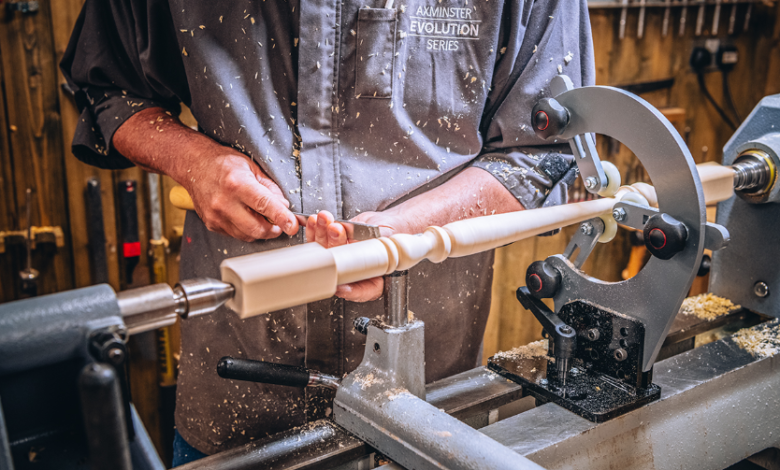How to Keep Long Pieces Steady While Turning

When machining long stock on a lathe, stability is critical. Without proper support, the workpiece can wobble, vibrate, or bend, causing poor finishes, inaccurate cuts, or even damaged tools. That’s where a steady rest comes in. This tool stabilizes the workpiece, especially far from the headstock, improving safety and precision for better results with longer materials.
Understanding What a Steady Rest Is
A steady rest is a key lathe accessory that supports long workpieces during turning. It prevents bending under cutting pressure, ensuring precise alignment with the lathe’s axis. It typically features a sturdy frame with adjustable arms or rollers to keep the workpiece stable and accurate.
There are three common types:
- Fixed steady rest: Mounted to the lathe bed, great for supporting mid-length points on the workpiece.
- Follow rest: Moves with the tool carriage to support the piece just behind the cutting tool.
- Rolling steady rest: Uses ball bearings or rollers for smoother, low-friction support.
Each type has unique benefits depending on your turning application.
When to Use a Steady Rest
You should consider using a steady rest when:
- The length of your workpiece exceeds three times its diameter.
- You’re machining long, slender components prone to deflection.
- You require consistent diameters and precise tolerances over the entire length.
- The material is soft or flexible, making it more susceptible to bending under pressure.
Using a steady rest in these situations helps reduce vibrations, minimizes runout, and protects your lathe tool from uneven wear.
Setting Up a Steady Rest Correctly
A steady rest is only effective if set up with care. Here’s how to ensure it performs optimally:
- Choose the Right Mounting Point
Position the steady rest as close as possible to the cutting zone without interfering with the tool. For longer parts, you may need more than one support point. - Center the Workpiece
Before tightening anything, make sure the workpiece is centered. Use dial indicators or measurement tools to get precise alignment. - Adjust the Fingers or Rollers
Carefully bring each arm into contact with the workpiece. Apply even pressure on all points. Too tight and you’ll restrict rotation; too loose and you lose stability. - Lubricate Contact Points
If your steady rest uses fixed metal fingers, apply oil or use brass or plastic tips to avoid marring the surface. Rolling contact points usually don’t need lubrication but should be checked for smooth motion. - Double-Check for Clearance
Rotate the workpiece by hand to ensure nothing binds. Also, make sure the tool has enough space to reach the cutting area without obstruction.
See also: Electric Vehicles: The Tech Behind the Shift
Best Practices for Long-Term Use
To make the most of your steady rest and preserve your lathe setup, follow these maintenance and operation tips:
- Inspect the steady rest regularly for signs of wear or looseness.
- Keep moving parts clean and lubricated to reduce friction and extend tool life.
- Avoid overtightening the arms, which can create flat spots or damage the workpiece.
- Use different contact points (e.g., rollers, bearings, soft pads) depending on material sensitivity.
- Train operators on proper setup and use to prevent mistakes that could damage the lathe or the part.
A consistent maintenance routine can significantly extend the lifespan of both the steady rest and your cutting tools.
Alternatives to Steady Rests (When You Don’t Have One)
While a steady rest is the most efficient tool for stabilizing long pieces, there are a few workarounds if one isn’t available:
- Tailstock support: Using a live center helps, especially at the free end of the workpiece.
- Homemade jigs: Some machinists create temporary supports from wood or metal brackets.
- Slower cutting speeds and lighter cuts: Reduces vibration, but also slows productivity.
- Intermediate chucking: Re-chucking the part closer to the tool reduces deflection.
These methods aren’t ideal for every situation but can be used for light-duty tasks in the absence of a proper steady rest.
Conclusion
Machining long workpieces on a lathe without a steady rest can be risky. It affects precision, causes vibration, and wears out tools faster. Adding a steady rest isn’t just helpful—it’s essential for clean, accurate, and safe results. By stabilizing your workpiece, it ensures consistent performance while protecting your tools and machinery. Whether you’re shaping shafts, rods, or other long components, a steady rest offers a simple and effective solution to a tough machining process.





